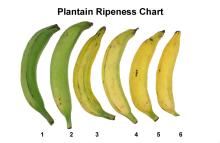Maturity and Quality
Maturity can be judged by the angularity of the fingers. Plantains are harvested mature-green and may or may not be ripened upon arrival at destination markets since plantains are eaten both at the mature-green stage and when fully yellow.
- Finger size (minimum length of 22cm = 9 inches)
- Freedom from mechanical damage, scars, insect damage, disease and chemical residues
Postharvest Handling and Storage
7.2–10°C (45-50°F) for up to 7 days
10–12°C (50-54°F) for longer than 7 days
| Temperature | 7.2°C (45°F) | 10°C (50°F) | 12.5°C (54.5°F) | 14°C (57.2°F) | 20°C (68°F) |
| ml CO2/kg·hr1,2 | 3-21 | 2-15 | 6-15 | 8-12 | 7-10 |
1 Low end for mature-green plantains and high end for ripening plantains.
2 To calculate heat production multiply ml CO2/kg·hr by 440 to get Btu/ton/day or by 122 to get kcal/metric ton/day.
Ethylene stimulates ripening of plantains. Thus, plantains that are marketed mature-green should be protected from exposure to ethylene. Plantains that are marketed ripe should be ripened with bananas (exposure to 100-150 ppm ethylene for 24-48 hours at 15-20°C = 59-68°F and 90-95% relative humidity).
90-95%
| Temperature | 7.2°C (45°F) | 10°C (50°F) | 12.5°C (54.5°F) | 14°C (57.2°F) | 20°C (68°F) |
| µl C2H4/kg·hr1 | 0.01-0.05 | 0.01-0.26 | 0.01-0.11 | 0.01-0.12 | 0.01-2.58 |
1 Low end for mature-green plantains and high end for ripening plantains.
- Optimum CA: 2% O2 and 5-10% CO2
- CA delays ripening, reduces respiration and ethylene production rates, and maintains overall appearance of the fruit
- CA may decrease the occurrence of subepidermal browning at marginally low temperatures
Disorders
Chilling Injury. Symptoms include peel browning, dull or smokey peel coloration, subepidermal vascular browning, abnormal ripening (possible acceleration); and in severe cases failure to ripen. Chilling injury results from exposure of plantains to temperatures less than or equal to 7.2°C (45°F) for 7 or more days, depending on cultivar, maturity, and temperature. Chilled fruit are more sensitive to mechanical damage and postharvest decay.
Skin abrasions. Abrasions result from skin scuffing against other fruit, surfaces of handling equipment, or shipping boxes. When exposed to low relative humidity conditions (<90%), water loss from scuffed areas is accelerated and peel color turns brown and in severe cases black, which is similar to severe peel browning associated with chilling injury.
Impact bruising. Dropping of plantains may induce browning of the flesh with or without damage to the skin. In some cases, damaged areas may become infected with fungal growth.
Crown rot. This disease is caused by one or more of the following fungi: Thielaviopsis paradoxa, Lasiodiplodia theobromae, Colletotrichum musae, Deightonialla torulosa, and Fusarium roseum – which attack the cut surface of the hands. From the rotting hand tissue the fungi grow into the finger neck and with time, down into the fruit.
Anthracnose. Caused by Colletotrichum musae, becomes evident as the bananas ripen, especially in wounds and skin splits.
Stem-end rot. Caused by Lasiodiplodia theobromae and/or Thielaviopsis paradoxa, which enter through the cut stem or hand. The invaded flesh becomes soft and water-soaked.
Cigar-end rot. Caused by Verticillium theobromae and/or Trachysphaera fructigena. The rotted portion of the plantain finger is dry and tends to adhere to fruits (appears similar to the ash of a cigar).
Control Strategies
Minimizing bruising; prompt cooling to 12°C (54°F); proper sanitation of handling facilities; hot water treatments (such as 5 minutes in 50°C (122°F) water and/or fungicide (such as Imazalil) treatment to control crown rot.
[For more information, see our publication “ Fruit Ripening & Ethylene Management ”, available for purchase using our Publication order form .]







